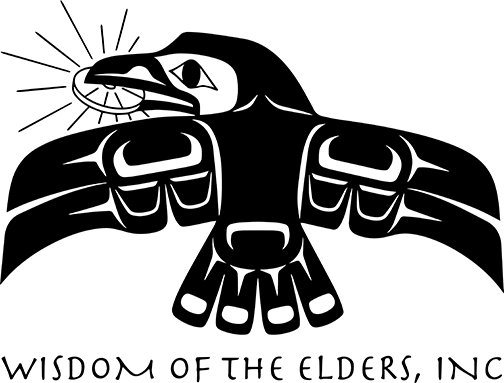
Joseph's Band at Lapwai, Idaho, 1877. Courtesy Northwest Museum of Arts and Culture/ Eastern Washington State Historical Society, L94-7.105 http://www.historycoop.org/journals/ohq/105.3/spence.html
The Nez Perce (Nimiipuu)
with Arlie Neskahi
Arlie Neskahi:
Welcome to Wisdom of the Elders. I’m Arlie Neskahi.
Three boys played in the late September sun. Their families were gathering camas roots and preparing foods for the winter in the nearby village. This was the homeland of the Nimiipuu, “the real people.”
Today, they are known as the Nez Perce. Their territory once comprised most of the Snake River drainage in today’s north central Idaho, and corners of Oregon, and Washington. They fished; they gathered roots and berries; they hunted deer and elk in a maze of lush valleys and mountain terraces. On this afternoon, September 20, 1805, the Nimiipuu numbered about seven thousand.
The three boys scattered when they saw the bearded white men riding toward them. Captain William Clark led an advance team of the corps of discovery to search for food and contact the people he called the Chopunnish,or pierced noses. Clark handed off his rifle and cornered two of the boys. It may be difficult for us today to imagine the boy’s terror as Clark attempted to calm them, giving them little gifts. National Park Ranger, Diane Mallicken, explains.
Diane Mallicken:
They had never seen anybody like this. Lewis found them, befriended them, gave them the pieces of ribbon. The little, the boys went running back to the village to tell the big news.
Arlie Neskahi:
Soon, the light-eyed strangers were invited to sit in the lodge of a headman. Villagers crowded into the tipi to have a look.
Diane Mallicken:
They thought these might be some people visiting us from the past. It might not be people from the here and the now. And they might have a message for us. To me, the value in even that thought is because of how spiritually minded people were at one time. There really was no delineation between natural and supernatural. It was all one.
Arlie Neskahi:
If there was a message, it was “your life is about to change.” Within thirty years, Presbyterians had established a mission at Lawai, Idaho, and soon a schism had formed in the tribe between Christians and Traditionalists. In 1855, the Nez Perce ceded about half of their homeland in exchange for a reservation of over seven million acres. Another treaty in 1868 took away more land.
Traditionalists grouped around the Joseph band in the Wallowa Valley of northeast Oregon. ordered to leave and move to the reservation, Joseph’s followers held out for a decade. The government sent general O. O. Howard to Lapwai. When a group of young Nez Perce men attacked some white settlers, Howard marched the army into the Wallowa.
What followed was one of the most famous campaigns of the so-called Indian wars. Joseph, with his brother Olokut and the war chief, Looking Glass, fled with their band across 1800 miles of mountainous territory toward Canada, fighting several bloody battles along the way. Finally, surrounded by superior forces, starving and believing all their people would be killed, Joseph surrendered just a few miles from the border, saying “I will fight no more forever.”
Joseph and his followers were permanently banished from their homeland. Despite this tragedy, Chief Joseph’s spiritual philosophy of peace and non-violence has caused people from all over the world to remember and honor him to this day.
I’m Arlie Neskahi, And this is Wisdom of the Elders.


